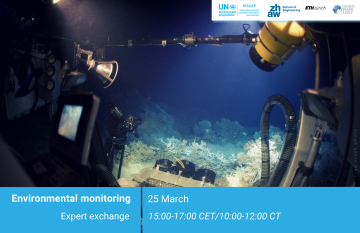
On 25 March 2022 15:00-17:00 (CET), the United Nations Environment Programme, Zurich University of Applied Sciences, ETH Zurich and the Global Trade Alert from St. Gallen University hosted an online expert exchange with researchers and specialists to dive into the benefits and obstacles of using digital technologies on environmental monitoring.
Experts shared their experiences and insights on the current state of play in environmental monitoring, described the digital technologies being applied and the mechanisms used for generating timely insights of environmental risks and environmental impact of human activities. Following this exchange, the experts discussed last mile challenges of environmental monitoring like data generation, collection, processing, and information uptake.
To conclude the session, experts were invited to wonder about the future of these monitoring efforts and the potential of digitally connecting environmental monitoring, supply chain traceability and green economy policy transparency.
The experts were:
- David Dao (Founder, GainForest)
- Crystal Davis (Director, Land & Carbon Lab, World Resources Institute)
- Mark Mulligan (Professor of Physical & Environmental Geography, King’s College London)
- Robert Guralnick (Associate Professor, University of Florida)
Meeting Agenda
| 15:00 - 15:10 | Tour-de-table with short introductions |
| 15:10 - 15:35 | Scoping environmental monitoring |
|
The aim of this opening session is to:
Structure:
Each participant (5 minutes per expert) will share their understanding of the goals and scope of environmental monitoring from their own unique perspective. Their interventions will serve as the basis for a common understanding on the relevance and purposes of these monitoring tools. Some guiding questions include:
|
|
| 15:35 - 16:30 | Last mile challenges and attribution of environmental change to human activities |
|
The purpose of this session is to:
Guiding questions: (Participants will have the opportunity beforehand to express their interest to focus on certain questions or raise new questions to peers in the discussion) Data generation
Data pooling and analysis
Communications and information uptake
Attribution of environmental change to human activities
|
|
| 16:30 - 17:00 | Conclusions and connections to other monitoring domains |
|
Each expert will have five minutes to cover one of the following questions. First, the speaker can identify particular technological challenges that need tackling to enable improved attribution of environmental changes to human activities. The identified technical questions can inform and feed into thinking around a challenge/hackathon to be organised under the UNEP project. Second, the expert is invited to reflect on possible links to other types of monitoring, specifically in terms of supply chain traceability and tracking economic policies. The reflection can identify areas of collaboration or raise questions to supply chain monitoring and green economy policy monitoring experts. Possible connection areas include: Nature risk and supply chain resilience; human activity attribution and environmental impact of supply chain;
Integration of environmental intelligence in economic policy agenda setting (eg. measuring progress towards political commitments and targets), policy formulation (eg. identifying risk areas of concentrated human activity combined with high environmental change), decision (eg. projecting how human activity will affect environmental change under different policy scenarios); policy intervention in particular on data to support the purposes of environmental monitoring;
This will be followed by a 10-minute open discussion allowing experts to react to each other’s reflections and contributions. It is expected that the open discussion will also serve to narrow down concrete takeaways and key messages from the environmental monitoring group that can be carried into the cross-domain dialogue. |
|
Key takeaways and areas of convergence
- Experts pointed to huge amounts of environmental data being collected, highlighting a growing numbers of sensors globally and increasingly high resolution data, but pointed out a gap between these environmental observations and measurements, and success in translating this into useful information and environmental intelligence. Experts noted an important role for monitoring tools upgrading and adding value to environmental data but also a large challenge here, where a greater focus on answers and solutions is needed.
- Experts also called for attention to who is driving the questions being asked, and emphasized that the monitoring community needs to seek to answer the questions being posed by those on the ground, including local and regional authorities and indigenous communities, not only by big players. In this respect, discussions also highlighted the importance of on the ground partners in monitoring efforts.
- Discussions also converged around data quality, and the need for accurate data. This includes in ensuring representative data where there are gaps, essential for avoiding bias in analysis, otherwise there is a risk that the solutions that come afterward will be flawed. It also includes false information, requiring attention to provenance of data, and to ensuring credibility of monitoring tools.
- Several experts characterised funding for environmental monitoring as more competitive instead of collaborative, and which has the effect of fragmenting a knowledge base and putting it in the hands of short term institutions that come and go, causing loss of information. Experts underscored the importance of longevity and stability in data collecting institutions.
- In terms of solutions, the focus for many experts lay on creating a stable framework and increased capacity around data, noting that the pace of technological innovation is already moving faster than our ability to absorb it. Views differed over the approach to the mechanism required, whether centralised or decentralised.
- Experts also pointed out that attribution of environmental changes to human activity should be the goal in some but not all circumstances and must be done in a discerning and sufficiently rigorous manner.
